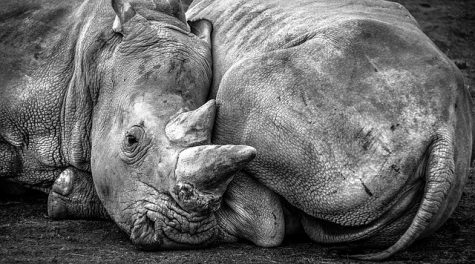Extinction: The Story of the Northern White Rhino
April 2, 2018
With the death of Sudan, the last male Northern White Rhino, an entire species is destined to evaporate from the earth. 45 years old, he had long suffered from age-related health problems, and veterinarians at the Ol Pejeta Conservancy made the difficult choice of euthanizing him to remedy his pain. His unfortunate death leaves his species, now consisting of his two daughters, without any possibilities of procreating. Ensuring this never happens again requires a comprehension of the factors that precipitated the extinction of Sudan’s species.
According to Jan Stejskal, a director at the zoo that sheltered Sudan for much of his life, “Sudan is an extreme symbol of human disregard for nature.” Mr. Stejskal is correct in his assessment of humans; human actions, such as poaching, industrialization and farming, and war have brought about the extinction of the Northern White Rhino, a species that numbered 2000 just 50 years ago. To progress on this issue, people need to realize that they and not a failure to adapt on the animal’s part are the cause of the extinction of various creatures.
In the last few years, poaching has seen a rebound due to the introduction of advanced technology and increased demand. Traditional East Asian medicine has long valued the rhino horn as a panacea, despite a lack of scientific evidence, but now demand has begun to grow in highly-developing nations such as Vietnam, causing the uptick in poaching incidents seen recently. When sold on the black market for $30,000 per pound (more than the worth of gold), rhino horns generate a pretty penny for the poachers who risk their lives to capture the rhinos. Fixing poaching, however, has no one-step solution, as poachers work for wealthy crime syndicates that have the resources to outwit local governments. Modern technologies such as GPS and low-flying helicopters have allowed poachers to find their victims easier, and then shoot them down with the aid of machine guns, grenade launchers, and night-vision goggles. Therefore, in order for poaching to be addressed, the world must join forces it to better suppress the black market. Moreover, people must be informed that rhino horns pose no medical benefit, and thus using them bears no fruit.
Secondly, industrialization and farming have played a large role in the extinction of the Northern White Rhino because of their direct correlation with habitat loss. As African nations become more developed, they demand more and more resources and space to fit their growing populations. When this occurs, animals suffer. Humans take their land, ejecting them from their natural habitats and relegating them to zoos as happened with the Northern White Rhino. This dilemma can be partially addressed by establishing more nature preserves for endangered and vulnerable species, but maintaining such parks can be difficult in unstable countries can be difficult. In countries without strong central governments, enforcing the law requires a concerted effort by the international community that includes military and monetary aid.
Upticks in violence across Africa have had detrimental effects on all species, but most notably on the Northern White Rhino, whose traditional home has been destroyed by constant warfare. The historical home of the Northern White Rhino spreads across South Sudan, the Congo, and Rwanda, which have seen large amounts of violence in recent times. Sudan’s civil war unleashed great destruction on South Sudan, destroying the environment of the region that once was home to thousands of rhinos. Driven out of their homelands, rhinos perished from famine and drought as they struggled to cope with moving into a strange and burnt landscape.
Considering modern technology, the future of the Northern White Rhino will most likely result in extinction. Scientists have attempted to breed the remaining female Northern White Rhinos with male Southern White Rhinos, but so far the program has not been successful. All across Africa, other animals risk facing the same rate as the Northern White Rhino, including the cheetah and lion. However, if the international community joins as a whole to not only advocate for but also physically protect all animals, more casualties may be avoided. A concerted effort is necessary, one that focuses on relaying the dangers of poaching, industrialization, and violence on animals. This is not easy, but if humans realize their wrongdoings and take steps to fix them, the future could change – for the better.
Sources:
https://www.awf.org/campaigns/poaching-infographic/


